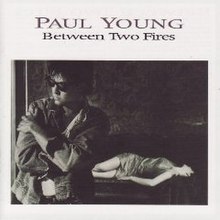| Between Two Fires | ||||
|---|---|---|---|---|
 | ||||
| Studio album by | ||||
| Released | 20 October 1986 | |||
| Recorded | 1986 | |||
| Studio | Lark Recording Studios (Carimate, Italy); Logic Studios (Milan, Italy). | |||
| Genre | Pop rock, soul | |||
| Length | 44:45 | |||
| Label | Columbia/CBS Records | |||
| Producer | Hugh Padgham Paul Young Ian Kewley | |||
| Paul Young chronology | ||||
| ||||
| Singles from Between Two Fires | ||||
| ||||
| Review scores | |
|---|---|
| Source | Rating |
| Rolling Stone | (3.5/5)[2] |
Between Two Fires is the third solo album by English singer Paul Young. Released in October 1986, it reached No. 4 on the UK Albums Chart, and No. 77 on the US Billboard 200 album chart. The album has been certified Platinum (300,000 copies) by the British Phonographic Industry.[3]
Between Two Fires follows the pattern of Young's first two albums combining cover versions with original songs written by Young and keyboard player Ian Kewley. However, after the numerous covers contained in the previous two works there were only two on this album with the Young/Kewley partnership contributing eight of the tracks, two co-written with bass player Pino Palladino.
Three singles were taken from the album; "Wonderland", "Some People", and "Why Does a Man Have to Be Strong", though none of these made the UK Top 20 unlike Young's previous singles. "Wonderland", written by Betsy Cook who also provided backing vocals on the album, reached No. 24 in the UK (Cook would later release her own version of the song on her 1992 album The Girl Who Ate Herself). "Some People" reached No. 56 in the UK and No. 65 in the US, while "Why Does a Man have to Be Strong" reached No. 63 in the UK.
- ^ "Music Week" (PDF). p. 30.
- ^ Rolling Stone review
- ^ BPI database Archived March 13, 2012, at the Wayback Machine